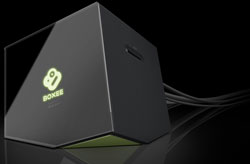
The Boxee video-on-demand software maker aimsto change the way consumers get free movie and TV entertainment from the Internet with its first hardware venture, called “Boxee Box.”
The open source software company debuted its new hardware device at the Music Hall of Williamsburg in Brooklyn, N.Y., on Monday. The new device, essentially a TV set-top box, will augment the current beta software that’s available so far only to invited testers. Boxee officials expect to have the first consumer TV boxes on sale for around US$200 during the second quarter of 2010.
Taiwanese networking equipment manufacturer D-Link will make the units that will allow users to browse Internet videos on their TVs without being connected to a dedicated Mac, Windows or Linux computer. The device will not need a hard drive or a keyboard.
“Before the release of the Boxee/D-Link device, potential users were forced to dedicate a multimedia-capable computer to hosting Boxee,” Bill Weinberg, principal consultant and independent analyst for Linux Pundit, told LinuxInsider. “While certainly loading Linux and Boxee onto an unused PC or — better yet — a Microsoft Windows Home Media-type device, is not rocket science, it is probably beyond the comfort zone and/or budget of manyconsumers.”
The Boxee Box is designed to make it more convenient for users to enjoy movies, TV shows, music and photos. The box will also grab content as streaming video from Internet sites including Netflix,MLB.TV, Comedy Central, Pandora, Last.fm and Flickr.
Boxee Design
The Boxee Box’s design may not win much praise from those with a conservative home decor, but it will clearly be a focal point of an entertainment center if the unit displayed on the company’s Web siteis what the for sale item looks like.
A little taller than a soda can, the cube has a blunted corner that gives it a modern art flavor. It was designed by Astro, who also designed the Xbox 360 and Alienware’s computers.
Despite its oddball shape, the Boxee Box is fully functional without the typical appendages attached to more traditional media center gear. While it has no internal hard drive, users can expand itsfunctionality with external storage devices through two USB ports and SD slots. The box, which displays 1080p, comes with built-in WiFi.
The back panel provides access to HDMI, optical, RCA cables and composite video connections. These make it handy to attach video cameras and TV sets. A rudimentary Web browser is hardwired inside. An included RF remote lets users access the set-top box from any room.
No Leg Up
Boxee may turn some heads with its hardware release, but it may not succeed on sheer innovation alone. Delivering Boxee realized on purpose-built hardware at a mass market price truly turns a project into a product, remarked Weinberg.
However, once you get beyond the fact that it is an exciting development, it has little revolutionary luster. Several free-floating FOSS projects have found their way into off-the-shelf systems. Asterix PBX on-premises IP telephony equipment and Carrier Grade Linux on network core/edge switches and routers are good examples, noted Weinberg.
“But it does appear that the Boxee/D-Link offering will be the first time that a new product takes its definition almost entirely from an existing open source project in the CE/video space,” he said. “A useful comparison lies with the venerable MythTV DVR project, which, while popular among hackers for creating a do-it-yourself personal video recorder, does not ship as the standard basis for ready-to-use commercial consumer devices.”
New Frontier
Boxee is indicative of a shift in the definition of “intelligent devices” from standalone embedded systems to content delivery vehicles.
The value of Boxee to end-users is not so much the function of the code itself, but of the content it channels into the home, Weinberg explained. Similar to proprietary devices and platforms like Roku, many Blu-ray players and DVRs, Boxee lets users access content from Netflix and video hosting sites like YouTube and Hulu over the Web.
“In that regard, I would say that Boxee is following a decade-long tradition of implementing key shared infrastructure with FOSS — like Linux does — but where the monetization occurs in another domain,” observed Weinberg, “in this case from integrating and selling Boxee systems and via a supply ofcontent by Netflix and other media outlets.”






















































